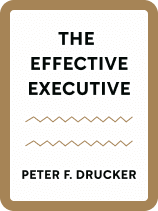

This article is an excerpt from the Shortform book guide to "The Effective Executive" by Peter F. Drucker. Shortform has the world's best summaries and analyses of books you should be reading.
Like this article? Sign up for a free trial here .
What unique contribution do you offer to your organization? How does your contribution improve the performance of the business?
Your job as an executive is to determine your contribution to the organization’s performance and results and to maximize it. According to management consultant Peter Drucker, contribution should be focused outward—that is, on what you can offer, as opposed to what you can get.
In his book The Effective Executive, Drucker outlines several ways in which you can focus your contribution outwardly.
Peter Drucker: What’s Your Contribution?
Drucker’s third practice for effectiveness is determining and applying your unique contribution. This means looking beyond your immediate work or task and being guided by the larger question, “What unique contribution can I make to significantly increase organizational performance and results?”
Drucker says most executives focus downward on handling short-term issues and tasks. In addition, many focus inwardly on what they can get from the organization rather than on what they can contribute.
However, Drucker argues that focusing outwardly on contribution is the key to quality and results, your working relationships, and the way you handle reports and meetings. When you think about your contribution, you see the bigger picture of how your skills and actions relate to the organization and its purpose. You also think in terms of the customer, client, or others with whom the organization interacts.
| Determining Your Contribution In The Effective Executive, Drucker leaves it up to the reader to determine her unique contribution for results. However, years later in a 2005 Harvard Business Review article, Drucker listed three questions executives and knowledge workers should ask to determine their contribution Instead of the typical question, “What do I want to do?”, ask: What does the situation require? Given my strengths, my way of performing, and my values, how can I make the greatest contribution to what needs to be done? What results have to be achieved to make a difference? Authors Gary Keller and Brian Tracy recommend asking other key questions to determine the most valuable thing you can do:In The One Thing, Keller recommends a “focusing question” that takes two forms: What’s my top priority (my most important goal)? and What’s the most important thing I can do right now to advance my top priority?In Eat That Frog, Tracy recommends asking, What are the key areas and expected results for my job?, then rating yourself on how you’re doing, where you need to improve, and what key skill would make the most difference if you developed it so that you excelled. Ultimately, your unique contribution to your organization might align with a personal strength, thus tying in with the fourth practice for effectiveness: maximizing strengths—yours and others’. |
Focus on Contribution in Relationships
Besides producing results, contribution should come into play in two other areas, according to Drucker: in your relationships with others at work and in your handling of meetings.
Peter Drucker’s contribution concept encompasses two areas:
- Communication and teamwork
- Self-development and development of others
1) Communication and Teamwork
Drucker argues that communication often doesn’t lead to the results companies or managers want because it’s one-way: Management communicates what it wants but employees aren’t receptive to the message because they weren’t asked for input.
Instead, executives should create two-way communication around contribution—first, by taking responsibility for their own contribution and results; then, by requesting the same from their employees by asking, “What contribution do you intend to make, and what’s our best use of your contribution (knowledge and ability)?” The two can then have a productive conversation. (Shortform note: By allowing for feedback, two-way communication creates a democratic environment, improves job satisfaction and efficiency, decreases confusion and ambiguity, and improves relationships.)
In contrast to manager-employee communication, knowledge workers often communicate peer-to-peer, contributing knowledge to those who need it, and in teams bringing together diverse knowledge and skills to address a single task (like caring for a particular patient in a hospital). For their contribution to be useful, Drucker says knowledge workers must take responsibility for being understood—that is, for ensuring that those who need information can make sense of it and apply it in the form in which they receive it.
(Shortform note: Team communication presents challenges when some or all team members work remotely. Tips for communicating effectively in remote or mixed teams include: keeping team documentation up to date, observing time zone etiquette, and considering how the medium affects communication—for instance, tone can be more difficult to convey and judge in an email conversation compared to a face-to-face conversation.)
| Autonomy Enhances Contribution Drucker doesn’t elaborate on how knowledge workers can enhance their contribution and their teammates’ other than by communicating clearly. However, a 2018 survey of knowledge workers by Slack indicates that with the right kind of support from managers, these workers can collaborate more and perform better. First, the workers surveyed want companies to invest in employees, which means paying competitively, providing the opportunity to master skills, providing autonomy, reducing bureaucracy, and having efficient processes and procedures. With this level of support, employees say they can collaborate successfully with coworkers and add value for customers. The employees surveyed particularly valued autonomy, underscoring Drucker’s contention more than 50 years earlier that knowledge workers required independence and support from managers, rather than being told what to do as task workers were. Today, the Slack report noted, autonomy is a key driver of collaboration and innovation. (Survey respondents defined a collaborative atmosphere as encompassing clear responsibilities and goals, ease of communication, and trust that colleagues will do good work.) Autonomy is also a key factor in job satisfaction, and it results in higher retention and greater productivity. However, autonomy requires agreed-upon goals, the necessary information to perform the job well, and the agency to move forward. Tech Problems Get in the Way For future knowledge workers to share knowledge effectively, companies will need to eliminate technology barriers. A 2018 Medium article quoting multiple studies notes that knowledge workers’ ability to find, retrieve, and transform information into a useful asset is critical. But more than 90% of information is “unstructured,” meaning it exists outside databases—within “content silos” such as documents, communication applications, and so on. Plus, it’s spread across teams using different devices, operating systems, and applications. Difficulty accessing information creates stress, inhibits effective communication, and wastes time and money. |
2) Development of Yourself and Others
Self-development is an outgrowth of focusing on contribution, Drucker says. When you ask what your most important contribution is, you’re also asking how you must develop yourself to make that contribution, what strengths you need to apply, and what standards you need to meet.
(Shortform note: Drucker doesn’t elaborate on how to develop yourself. However in Eat That Frog, Brian Tracy offers advice on improving your skills to increase your value and productivity: Determine what you need to learn in order to do your job better, identify your most important tasks and capabilities, then draw up a plan to continually upgrade your skills in these areas.
Further, in The Miracle Morning, Hal Elrod explains how to implement seven daily self-development practices: silence, affirmation, visualization, exercise, reading, and writing.)
Drucker says when you develop yourself to enhance your contribution, you also motivate everyone around you to develop themselves. For example, when an athlete sets a record, she resets the bar for every other athlete; average athletes then begin exceeding the old records, while the best begin breaking the latest record, so that everyone’s performance improves.

———End of Preview———
Like what you just read? Read the rest of the world's best book summary and analysis of Peter F. Drucker's "The Effective Executive" at Shortform .
Here's what you'll find in our full The Effective Executive summary :
- How to manage yourself before you can manage others
- The five practices that anyone can learn to be more effective
- Why leaders should purposely create disagreements






